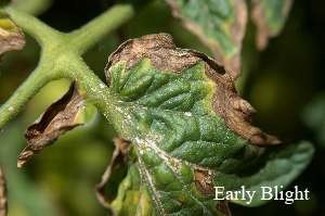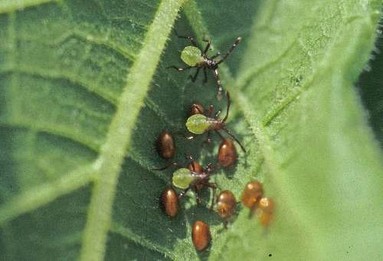Vegetables: Disease and Pests
Tomato Leaf-Spot Diseases
Septoria leaf spot usually appears earlier in the season than early blight and produces small dark spots. Spots made by early blight are much larger and often have a distorted “target” pattern of concentric circles. Heavily infected leaves eventually turn yellow and drop. Older leaves are more susceptible than younger ones, so these diseases often start at the bottom of the plant and work up.
Mulching, caging, or staking keeps plants off the ground, making them less vulnerable. Better air circulation allows foliage to dry quicker than in plants allowed to sprawl. Mulching also helps prevent water from splashing and carrying disease spores to the plant.
In situations where these diseases have been a problem in the past, rotation is a good strategy. It is too late for that now, but keep it in mind for next year. Actually, rotation is a good idea even if you have not had problems in the past. But many gardens are too small to make it practical. If you have room, rotate the location of the tomatoes each year to an area that has not had tomatoes or related crops (peppers, potatoes, eggplant) for several years.
If rotation is not feasible, fungicides are often helpful. Be sure to cover both upper and lower leaf surfaces, and reapply fungicide if rainfall removes it. Plants usually become susceptible when the tomato fruit is about the size of a walnut. Chlorothalonil is a good choice for fruiting plants because it has a 0-day waiting period, meaning that fruit can be harvested once the spray is dry. Chlorothalonil can be found in numerous products including Fertilome Broad-Spectrum Landscape and Garden Fungicide, Ortho Garden Disease Control, GardenTech Daconil and others. Be sure to start protecting plants when the disease is first seen. It is virtually impossible to control this disease on heavily infected plants.
If chlorothalonil doesn’t seem to be effective, try mancozeb (Bonide Mancozeb Flowable). Note that there is a five-day waiting period between application and when the fruit can be harvested. You may wish to pick some tomatoes green just before you spray if you use Mancozeb as the tomato fruit will ripen inside. (Ward Upham)
Pests:
Squash Bugs
Because squash bugs feed by sucking juice from the plant, only insecticides that directly contact the insect will work. General use insecticides such as permethrin (Bug-B-Gon Multi-Purpose Garden Dust, Green Thumb Multipurpose Garden and Pet Dust, Bug-No-More Yard and Garden Insect Spray, Eight Vegetable, Fruit and Flower Concentrate, Garden, Pet and Livestock Insect Control, Lawn & Garden Insect Killer), malathion, and methoxychlor provide control if a direct application is made to young, soft-bodied squash bugs. This means that you MUST spray or dust the underside of the leaves because this is where the insects live. (Ward Upham)






Leave a Reply
You must be logged in to post a comment.